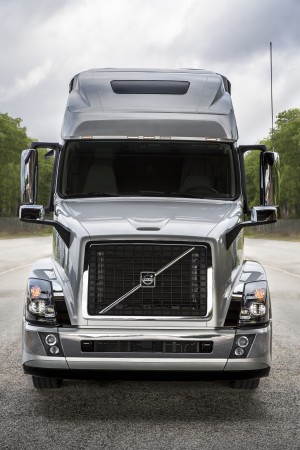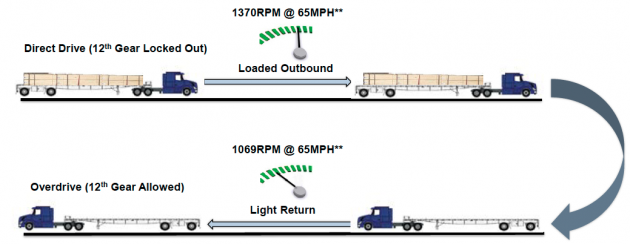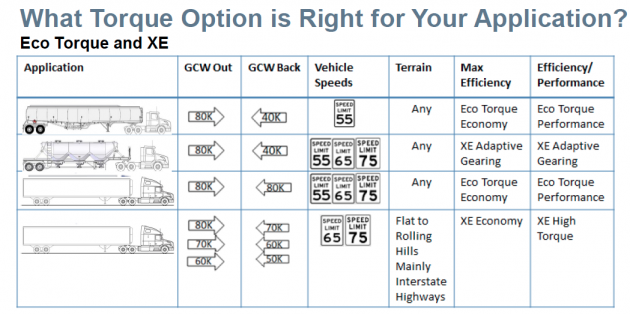The 2016 model year Volvo VNL featuring Adaptive Gearing
DUBLIN, Va. — You’ll have to take a good hard look at the front end of a 2016 model year Volvo VNL to notice the subtle design enhancements built into the new models. However, where you’ll really notice the improvements without much effort at all is on your fuel statements and bottom line, where an expected 3.5% fuel economy gain is expected to show up.
Based on US fuel prices of $4 per gallon and averaging 7.5 mpg over 100,000 miles, Volvo says these enhancements can reduce fuel costs by about US$2,000 per year. Bank on a few hundred more if you’re gassing up in Canada.
Of the enhancements that are expected to give you a fuel economy boost, some can be found on the exterior and others under the hood. The 2016 VNL will feature a new bumper design that extends closer to the ground, to deflect more air underneath the steer axle. A patented wing-shaped piece has been added to the lower rear portion of the bumper, also to direct air underneath the truck and away from obstructions. And the bumper end caps have been redesigned to guide more air around the vehicle rather than underneath it. Volvo will continue to offer its back-of-cab-mounted trim tab, which directs air directly onto the top of the trailer for improved flow along the length of the vehicle. New flared chassis fairings offer improved aerodynamics on trucks with short wheelbases by kicking the air away from the wheels and down to the trailer skirts.

The VN670 has been given a standard roof update that more closely mirrors that of Volvo’s fuel economy leader, the VN780. Volvo has updated its chassis packaging by, for example, offering a 50-gallon fuel tank on the right-hand side in place of the previous 75-gallon tank used for long-haul applications. This provides more flexibility for installing APUs and other equipment along the frame rail.
Underneath the hood, the cooling fan has received a more efficient blade design and a better-designed electronic viscous clutch for improved cold start disengagement. The redesigned fan is expected to add a 0.7% fuel economy improvement, said Jason Spence, manager of product marketing with Volvo.
Volvo has also relocated the heat exchanger on its I-Shift, bringing it from the radiator to the side of the transmission itself. Spence said this allows Volvo to get the oil up to its ideal operating viscosity more quickly and to more effectively hold it there within a tighter temperature range. It also reduces the amount of tubing required. This should add a 0.3% fuel economy improvement.
Yes, fuel economy gains are now being measured in tenths of a percentage point, but they all add up.
Every Volvo VN will see some or all of the updates described above. The underhood changes will be applied across the board while the aerodynamic enhancements will be given to the models that require them. The VN670 has the most to gain and will receive the full complement of upgrades. Some of these advances, noted Spence, were inspired by Volvo’s DoE Supertruck experience.
Also new for 2016 is adaptive gearing, an extension of Volvo’s popular XE (exceptional efficiency) powertrain package. The XE package downspeeds the engine through a combination of specifications including the D11, D13 or D16 engine coupled with the I-Shift transmission with 0.78:1 ratio, fast rear axle ratios and low-profile tires. Every 100 rpm of downspeeding translates to a 1.5% fuel economy improvement.
Volvo’s new adaptive gearing option is ideal for fleets that go out loaded and return empty and don’t exceed a GVW of 80,000 lbs. It’s especially effective at higher speeds of 65-70 mph, Volvo claims. This option will have limited appeal in Canada because of our heavier payloads and lower speed limits, but it will still have its place. Bulk, end-dump, tanker and flatdeck applications are the best suited for adaptive gearing, explained John Moore, product marketing manager with Volvo.

“It’s application-specific,” he said. “We get better numbers when making specific drivetrains for specific applications rather than doing one size fits all.”
Adaptive gearing effectively provides the operator with two drivelines in one. Load-sensors on the suspension detect when the truck is heavily loaded and instruct the I-Shift to lock out 12th gear, allowing the transmission to run in direct drive 11th gear for improved fuel economy with no parasitic losses. Once the truck is unloaded, 12th gear in overdrive is given back to the driver for greater speed and improved efficiency while running empty or lightly loaded. This becomes a racy truck, especially when the I-Shift’s Performance Mode is activated. Adaptive gearing will be offered with the D11 and D13 engines with I-Shift transmission.
Adaptive gearing works best at speeds of 64 mph or greater. Of course, customers looking for greater fuel economy savings could simply slow down, an observation that wasn’t lost on Volvo’s Spence. But he pointed out many states have speed limits of 70-plus mph and Volvo doesn’t want to preclude itself from selling trucks to those operators who like to run the limit.
“Every truck running down this interstate is running close to the (70 mph) speed limit,” he said as we drove down I-81 pulling an empty flatdeck at, well, 70 mph, with an engine speed of just 1,151 rpm. “We design trucks to run 60-65 mph and we spec’ them that way but the reality is trucks run faster than that and we understand that. We want to make sure we can still make efficient trucks that are running faster and we also want to make trucks that are designed to meet operational needs. A lot of guys that buy our trucks run out heavy and come back empty and we’re making trucks that are adaptive to those situations so they get the best fuel economy in all their operations.”
I also got to pull a loaded flatdeck grossing 63,500 lbs along the same route to experience the locked-out 12th gear. The performance wasn’t lacking in any way, even when deprived of top gear.
Heavy payloads exceeding a GVW of 80,000 lbs, slow road speeds and mountainous terrain will rule out XE-Adaptive Gearing from consideration by many Canadian customers, who in most cases will be better served by the XE 16, rated up to 143,000 lbs. Basically, whatever your operation entails, Volvo seems ready with an off-the-shelf powertrain specification that will work for you right out of the box. It’s the versatility of the I-Shift transmission and its integration with the engine and other downstream components that allows this, and Volvo is taking full advantage of the opportunities this integration affords. They’re effectively changing how vehicles are spec’d and taking a lot of the guesswork out of the equation.

A new weapon in Volvo’s arsenal is a recently completed on- and off-road track outside its New River Valley truck plant. Here, customers and prospective customers who don’t hold a CDL can put new VN and VHD trucks through their paces.
The paved portion is a good place to experience the full range of capabilities offered in the I-Shift transmission. For example you can get on the throttle coming out of the turn and quickly reach highway speeds before then channeling the full braking power of the engine brake by pressing down on the control stalk for several seconds. This prompts the I-Shift to drop a gear and apply full engine braking, which will virtually bring the truck to a stop while saving the service brakes.
It’s also a great place to test the “idle drive” feature. Idle drive comes into play when you want to roll forward at a controlled pace without working the foot pedals. Say you’re in a traffic jam and traffic has slowed to a crawl. You can depress the minus button on the cruise lever for three seconds to enable idle drive and then adjust your speed and gears up and down using the plus and minus buttons on the shifter. This feature works at speeds of up to 7 mph and from first gear through sixth.
Every time I drive a truck with I-Shift I find something new to like about it. So do others, apparently. Volvo says 92% of its trucks are now being ordered with Volvo power and 74.7% with the now-standard I-Shift. Before the I-Shift was standardized in early 2013, it had a take rate of about 45%.
In addition to a paved 1.1-mile track, the new Customer Experience Track also provides an off-road playground for the VHD vocational truck. Here, you’ll find two 27% grades, a variety of rough, undulating surfaces and various other impediments that will give you pause before proceeding. The I-Shift destroyed this course. It wasn’t even difficult. The control the I-Shift gives the driver and the resulting confidence it instills will put to rest any notions about this being a purely linehaul product. It’s unnerving to look down a 27% grade, but the I-Shift immediately takes control for a slow and methodical descent. Stopping halfway up that same 27% grade seems like a bad idea, but I-Shift thinks nothing of it. I realize it’s improper to credit an inanimate object with ‘thinking,’ but the ‘I’ in I-Shift stands for ‘intelligence’ and it’s obvious why.
Volvo’s latest innovation – XE-Adaptive Gearing – will likely be a niche specification within the Canadian marketplace, but the majority of the improvements built into the 2016 model year VN will be enjoyed by all customers. The new trucks will go on sale in early 2015.
Have your say
This is a moderated forum. Comments will no longer be published unless they are accompanied by a first and last name and a verifiable email address. (Today's Trucking will not publish or share the email address.) Profane language and content deemed to be libelous, racist, or threatening in nature will not be published under any circumstances.
I have Volvo 2011, def system scr, acm all crab. How is it improved in 2016.
@sam – 2011 models were having def problems as that was the year when def was implemented and that was a transition period the problem minimized in 2012 a bit as newer models started coming up with more improvement year after year.. after 2014 everthing become stable ..
When will Volvo upgrade the dash , good quality truck erganomics need to be improved.
I have volvo 670 ..2015 model truck. .the speed cruise is not working. .please suggest. .
-
Check your switch on your break pedal
MY NEW VOVLO (SHAKES) PARTS ARE COMING (LOSE) NO HELP FORM DEALER AND VOLVO GUEST RUN AROUND!!!
volvo SUCKS my 16 volvo still SHAKES











Hello,
I have D13 automatic 5 axles truck which DEF is not getting used so what is problem.
Thanks